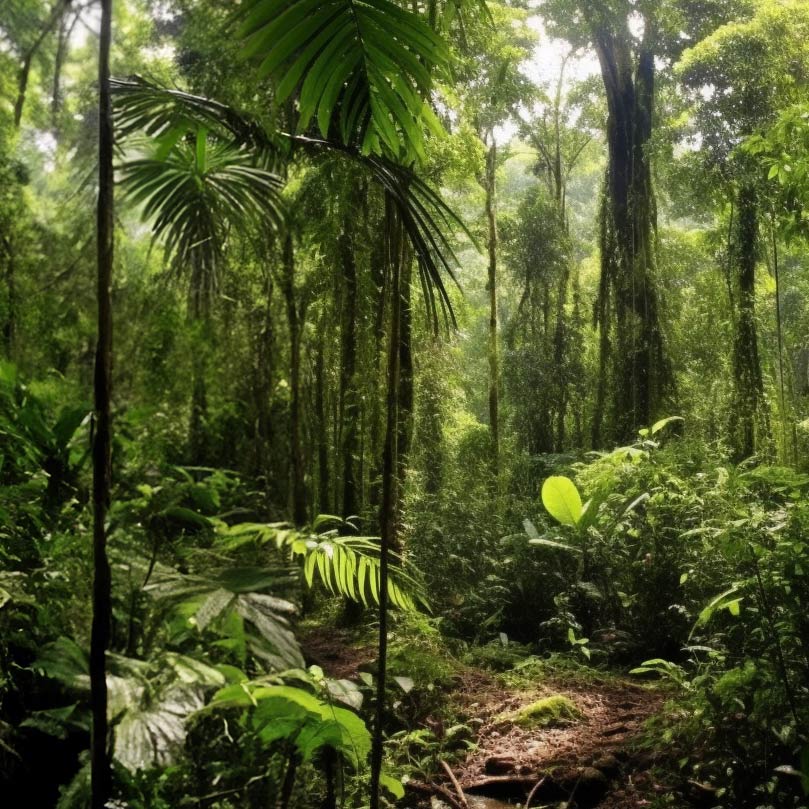Carbon
Everything consists of carbon.
We must recognise unseen molecules to understand our world and its molecular composition. For example, water molecules, imperceptible except as raindrops or vapour, originate from plant photosynthesis. This volume remains stable due to carbon circulation.
You unavoidably inhale carbon dioxide, composed of two oxygen molecules bonded to carbon. Unless winds are strong, you even inhale some of the carbon dioxide you exhale.
The decreasing leaf and grass area is a concern, which limits freshwater production. The air you breathe contains fewer oxygen molecules due to this.
Droughts result from reduced photosynthesis, while burning fossil fuels leads to excess water, causing floods. Aircraft emissions, liquidised in the atmosphere, contribute to this process.

Understanding Climate Gasses, CO2, and How Plants Help
Carbon is a big deal on Earth. It’s the fourth most common thing in the universe after hydrogen, helium, and oxygen. Carbon makes up all living things, like plants, animals, and us! It moves around the Earth, in the land, air, oceans, and deep inside the Earth in the carbon cycle process. This carbon cycle has two parts: one that takes millions of years and another much quicker, taking only days to thousands of years.
How Carbon Became a Part of Earth
A long time ago, small space rocks and meteorites with carbon hit Earth and added more carbon. Carbon is no longer added this way but has been spread out in different parts. Over time, carbon dioxide from the air mixed with water to form carbonic acid. Combined with other elements, this acid turned into carbonates, which washed into the oceans. Sometimes, these carbonates get pulled deep into the Earth and later emerge as carbon dioxide through volcanoes. This cycle has been balancing the amount of carbon dioxide in the air for a long time. There was a time when there was much more carbon dioxide in the atmosphere, but living things changed that.
How Plankton Changed Our Air
Tiny ocean plants called phytoplankton used sunlight to make food and release oxygen into the air. They also created a lot of carbon-based stuff that got eaten by tiny ocean animals. Only a little bit of this carbon stuff sank to the ocean floor, but over time, it added up and removed a lot of carbon from the air. On land, huge forests did a similar thing. They took in carbon dioxide and released oxygen. Over time, these forests turned into coal. So, the oceans and the forests helped take out a lot of carbon from the air and made it like it is today.
What’s Happening Now with Carbon?
Nowadays, trees, plants, and ocean plankton still help balance the carbon in our air. They take in carbon dioxide and release oxygen during the day. But this process stops at night or when it’s cold or dry. The fantastic thing is that plants also give out a lot of water into the air. In fact, plants release so much water that burning fossil fuels is many times more than the carbon added to the atmosphere. Also, not all carbon is the same. Some carbon has been around for a long time, and some are newer. This can be told by looking at specific types of carbon called isotopes.
Where is All the Carbon Stored?
Most of the Earth’s carbon is stored deep in the oceans or rocks. A smaller amount is in the atmosphere, plants, and soils. Some studies say that forests store about 638 billion tons of carbon, while others think it’s around 359 billion tons. There’s still a lot to learn about this.
Wood’s Role in Storing Carbon
When we think about storing carbon, wood is vital. Some woods last a very long, so they hold onto carbon for longer. For example, if you compare seaweed and a wooden log, the seaweed will break down and release its carbon quickly, while the log will keep its carbon for many years. That’s why forests are so valuable for storing carbon. Forests with older trees are even better because they’ve been holding onto carbon for a long time.
Why Soil is Important Too
Soil is another prominent carbon storage place. Trees help make the soil richer in carbon. Some soils can hold onto carbon for more than 4,000 years. This is why it’s crucial to have forests and other lands that can store carbon for a long time.
In summary, carbon is everywhere and plays a significant role in life on Earth. How it moves around the planet and how living things, like trees and plankton, help control it is terrific. This is why it’s crucial to understand and protect our natural carbon storage, like forests and oceans.
Understanding the Fossil Subsidy and Biofuels
Fossil and biotic carbon differ significantly in how they impact our planet’s biosphere. Historically, while the deforestation caused by humans played a part in initiating global warming trends, the modern-day burning of fossil fuels contributes new carbon to the atmosphere at an alarming rate. This environmental damage can be seen as a hidden cost of using fossil fuels.
There’s a pressing need for international discussions, such as those held by the IPCC or CCC, to address the “Fossil Subsidy.” This subsidy overlooks the differences in the environmental impacts of fossil and biotic carbon. Unfortunately, many governments have been reluctant to acknowledge their global responsibilities, often due to their heavy reliance on fossil fuels for economic growth. Such dependence on fossil fuels can blind nations to the long-term harm they cause, not only to themselves but globally.
By distinguishing between fossil and biotic energy sources and assigning different values, we can shed light on economies that rely heavily on fossil fuels. This differentiation could help developing nations avoid potential pitfalls. Furthermore, considerations like the environmental cost of cement production should be factored into evaluating future development projects.
Biofuels: A Glimpse into Humanity’s Energy Past and Future
Humans’ relationship with energy began with fire, fueled primarily by wood. Over time, biofuels have evolved to include materials like ethanol and even fixed oils for diesel engines, serving as potential substitutes for fossil-derived fuels. With the escalating energy consumption globally, biofuels are poised to become a key component of renewable energy solutions.
While biofuels present a sustainable alternative to fossil fuels, evaluating their actual cost is crucial. This includes considering the amount of fossil fuel needed for biofuel production and the subsequent impact on the environment, biodiversity, and water quality. Specifically:
Fossil energy ratio: It’s concerning that the energy used in food production now exceeds the energy derived from consuming it. This ties food prices directly to fossil fuel costs, threatening food security.
Biodiversity considerations: We’ve witnessed invaluable ecosystems being replaced by vast monocultures for biofuel production. The cost of this loss must be factored in to determine the sustainability of such actions.
Water quality: Forests play a critical role in ensuring water quality. Disruptions to these ecosystems, such as logging, adversely affect this quality. As water becomes an increasingly valuable resource, its quality should be a priority in biofuel production decisions.
Biomass plantations: Similar to biofuels, these plantations aim to produce wood and fibre. Their carbon sequestering capabilities are limited, especially when considering their short lifespan.
Rethinking Our Approach to Atmospheric Gasses
The atmosphere, a common asset all share, is intricately linked with life processes that have balanced it for aeons. Historical deforestation has disrupted this equilibrium, which can be addressed by restoring lost forests. However, merely reforesting won’t be enough to combat the fossil carbon problem.
Our hope may lie in the planet’s degraded ecosystems, which hold immense growth potential. If global efforts were directed toward restoring these ecosystems, we could harness the power of photosynthesis to rectify our current trajectory and cultivate a more sustainable future.



